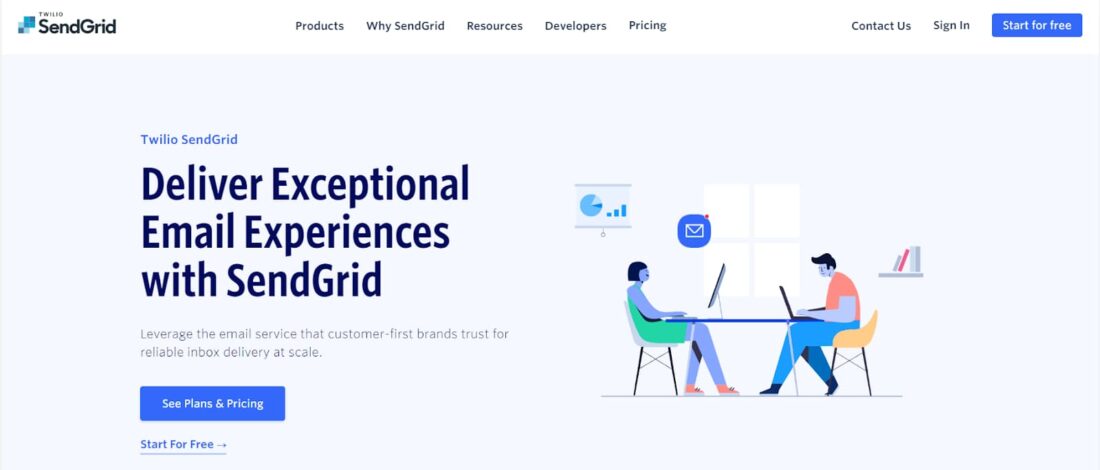This article outlines vital steps that every small business owner should adhere to while formulating and executing an email marketing campaign. Like any structured event, an email marketing campaign can be divided into three key phases: planning, implementation, and assessment of results.
In the following sections, we delve deeper into each stage. You’ll understand the significance of establishing your objectives from the outset, how to build a list of potential subscribers, the type of content that is more likely to generate leads, which key performance indicators are essential when evaluating the success of your efforts, and other key elements.
Despite the overwhelming popularity of social media platforms like Facebook and Twitter in recent years, email marketing continues to be an effective way to engage with your target audience. As predicted by Statista, the total number of email users worldwide will astonishingly reach 4.730 billion by 2026.
Small businesses can accomplish various objectives through email marketing campaigns. They can use emails to promote their products or services, increase brand awareness among potential customers, persuade them to subscribe to newsletters or visit their blog, download their most recent ebook, and so on. In essence, the primary purpose of email marketing is to provoke a reaction from the target audience.
However, merely crafting a message and randomly distributing it to several email addresses won’t yield significant results. It’s akin to a door-to-door salesman knocking on every house in the neighborhood, hoping for a positive response. Most often, the results are not worth the time and effort invested.
The appropriate strategy involves developing a robust email marketing plan. With the rapid increase in marketing emails each year, small businesses must make additional efforts to distinguish themselves. They must endeavor to compose compelling emails that immediately grab the recipient’s attention, prompting them to open the message, read its contents, and ultimately click on the call-to-action button. This challenging task necessitates substantial preparation.
Don’t worry, though. Below, you’ll find some key guidelines common to all successful email marketing strategies. Adhere to these, and hopefully, your key performance indicators, such as delivery and open rates, will begin to improve.
The Ultimate Secret of Successful Email Marketing Strategies Unveiled: Plan, Execute, Evaluate
Laying the Groundwork for Your Outstanding Email Marketing Campaign
#1: Determine Your Ultimate Goal

Before embarking on any venture, it’s crucial to consider the end goal. This is true for a builder who visualizes the finished house before placing the first brick, and it’s equally applicable to an email marketing campaign. The success of your email marketing strategy hinges on having a clear understanding of the expected outcome.
Every action you take, including the design and content of your emails will be guided by this overall objective. Your campaigns can aim to achieve multiple goals such as:
- Increasing website traffic
- Boosting product sales
- Creating brand awareness
- Retaining existing audience
Without a clearly defined target, your campaigns may lack direction, much like a ship lost at sea. However, merely stating your desired goal isn’t sufficient. A good goal should meet several key criteria.
- It should have a specific timeline for execution. Although start and end dates can be flexible, you need to mark out a timeframe on your marketing calendar.
- It should be realistic. Don’t set overly ambitious digital marketing goals. For instance, aiming to gain 500 subscribers in a week might be unattainable for a small business. Start by researching your industry to understand average performance metrics.
- It should be specific. For example, aiming to increase the click-through rate for your emails by 15% in a month is more precise than just wanting to improve the click-through rate.
- It should prompt proactive steps towards achievement. If your goal is to retain customers through engaging content, consider incorporating animations or videos in your emails.
By knowing exactly what you want to achieve, when you want to achieve it, and how to go about it, you can maintain better control over your campaigns.
#2: Create a Recipient List and Categorize Addresses Into Relevant Groups

Successful email marketing strategies also rely on having a list of verified subscribers who have chosen to receive emails. Sending emails indiscriminately is unlikely to yield positive results.
So, how can you create and grow your subscriber list? Here are a few popular methods:
- Include a subscription form on your website pages without disrupting user experience. Ensure there’s an “opt in” checkbox to comply with legal requirements.
- Use physical forms at events such as conferences or fairs.
- Organize a contest. For example, if you sell smartphones, quiz your audience about specific features of a brand and offer a reward.
- Conduct a survey. Ask subscribers or potential customers to provide feedback on your products in exchange for a promo code. Their responses can help refine your future email marketing campaigns. Remember, never buy pre-made subscriber lists. The authenticity of the addresses is uncertain and compromised addresses could lead to your emails being marked as spam.
However, having a subscriber list is just the beginning. You need to further categorize these addresses into various groups to make your emails more relevant to your target audience. You can segment your list based on factors like education, age, gender, location, and buying habits. For instance, if a customer consistently purchases a particular item, you can recommend similar products in your emails, potentially increasing your click-through and open rates.
#3: Opt for a Robust Email Marketing Automation Tool

The reality is this: managing subscriber lists, segmenting your customers and prospects into targeted groups, and monitoring the success of your email marketing campaigns necessitate the use of specialized software. Attempting to perform these tasks manually is time-consuming and prone to errors.
Thus, successful email marketing strategies involve selecting a robust and efficient automation tool. For optimal results, such applications should possess several key features. These include seamless third-party integrations, refined A/B testing, comprehensive analytics and reporting capabilities, versatile autoresponders, and a user-friendly content editor, among others.
Building the Perfect Email
Now that you’ve prepared for your email marketing campaign, it’s time to delve into the finer details. Every aspect of your email is crucial for achieving your primary objective. Here are some key points to consider.
#4: Lure Your Subscribers With an Attractive Subject Line
Various email marketing strategies exist. Regardless of the one you select, one vital rule remains for crafting effective emails: create an enticing subject line.
Why is it so important? A typical customer’s inbox is flooded with emails from various businesses competing for their attention. If you can’t lure the recipient to open your email instantly, you’ve lost the battle.
Here are some best practices for crafting compelling email subject lines:
- Keep the subject line as concise as possible.
- The subject line should highlight the value of your offer before anything else. For instance, mention a discount or free consultation. Inform your subscribers about what they stand to gain from your company rather than focusing on your product’s features.
- Prompt the recipient to act promptly. You could use phrases like “before the price increases” or similar.
- Personalize your subject line. Email marketing automation tools enable you to dynamically insert recipients’ names into subject lines, making emails more personal.
Remember that dull, uninteresting subject lines are a primary reason recipients ignore marketing emails.
#5: Develop Unique and Captivating Content

A subscriber has opened your email. Kudos on crafting an excellent subject line! Now your challenge is to maintain their attention until the end of your message, where the most crucial content element is likely located – a call to action.
How can you achieve this? Here are some essential tips:
- Ensure your title is as captivating as your subject line. The title’s purpose is to engage the recipient and encourage them to continue reading. The title should reflect the subject line, repeating the value the subscriber can gain from your offer using different words and phrases.
- Keep your content easy to understand:
- Start with the main point and then add supporting details.
- Keep your sentences, paragraphs, and overall text as brief as possible.
- Avoid repeating words and phrases from previous campaigns.
- Break up the text into numbered or bulleted lists where appropriate to make it easier for subscribers to comprehend.
- Include appropriate headings for your paragraphs, adhering to the correct hierarchy (from H2 to H6).
- Reference external materials that your target audience may find helpful.
- Place a single call-to-action at the bottom of your email. This is usually a button. Make it stand out within the body of the message (use a different color, border, specific font, etc.).
- Refrain from using too many images.
- Avoid industry jargon and complex vocabulary. Use simple language that everyone can understand.
| IMPORTANT!Include an unsubscribe link in your email footer. Your target audience should have an easy way to opt out of your newsletters if they choose to. This is also a legal requirement in many jurisdictions. |
#6: Ensure Your Email Displays Perfectly Everywhere

Every triumphant email marketing strategy emphasizes one crucial aspect: exceptional presentation of emails, regardless of the device used by the recipient to view them.
Initially, you must ensure your email complies with the standards of the respective marketing automation platform, like SendGrid. But that’s just the start. It’s also imperative that your message is accurately displayed across various email clients and devices. Be it PCs, Macs, laptops, smartphones, or tablets, your subscribers should receive a perfectly rendered message.
You could opt to test your emails by sending them to colleagues or friends and request their feedback. However, this process can be laborious and time-consuming. The variety and number of mobile devices and email clients your testers use may not be sufficient to give you peace of mind.
A more efficient solution would be to engage a professional email template development company that offers a wide range of services. These services include PSD to HTML email template conversion, integration of email templates into various ESPs like MailChimp or Sendgrid, and testing email templates across different browsers, devices, and email clients, to name just a few. This approach ensures that your message will be displayed consistently to all recipients.
Assessing the Outcomes
#7: Regularly Track the Key Performance Indicators During Your Campaigns

Even if you have crafted a perfect email by following the guidelines above precisely, without the relevant analytical data, you’ll be in the dark, uncertain if your set goals have been met.
Fortunately, most (if not all) email marketing solutions offer analytical and reporting features enabling marketers to track the key performance indicators of their campaigns. These include:
- Delivery rate
- Open rate
- Click-through-to-open rate
- Unsubscribes rate
The exact figures differ across industries, so ascertain the average for your industry. Then, modify your emails based on this data. For example, low open rates typically indicate that your subscribers find your subject lines dull. Make them more appealing and value-driven.
Conclusion
Email marketing remains a potent tool for nurturing prospects and maintaining existing customers. As the population of email users worldwide is predicted to rise in the future, this digital marketing medium presents a promising outlook for small businesses.
Various email marketing tactics exist, each with their unique characteristics and recommended practices. However, they all adhere to some shared fundamentals. Specifically, every email marketing campaign can be split into three primary phases: planning, executing the campaign, and assessing the data.
In this article, we have discussed each of these stages. While this information only represents a small fraction of the expansive world of email marketing, we hope it sets you on the right course towards achieving your marketing objectives. We wish you good luck on this journey!



